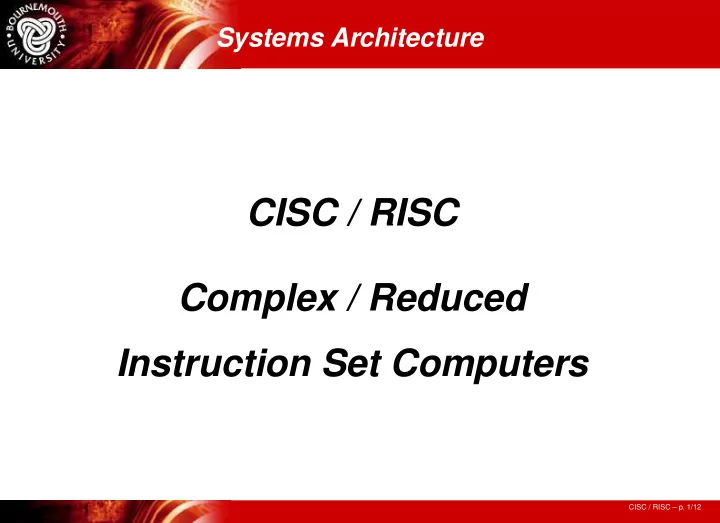

Systems Architecture CISC / RISC Complex / Reduced Instruction Set Computers CISC / RISC – p. 1/12
Instruction Usage Instruction Group Average Usage 1 Data Movement 45.28% 2 Flow Control 28.73% 3 Arithmetic 10.75% 4 Compare 5.92% 5 Logical 3.91% 6 Shift 2.93% 7 Bit Manipulation 2.04% 8 I/O & Others 0.44% CISC / RISC – p. 2/12
Programming Observations 56% of constants ± 15 (5 bits) • 98% of constants ± 511 (10 bits) • 95% of subroutines require less • than 6 parameters (arguments) Instruction Usage and Programming Observations lead to a smaller, less complex, instruction set CISC / RISC – p. 3/12
RISC / CISC Comparison (1/2) Characteristics RISC CISC 1 On chip registers Many ( > 30) Few (2–16) 2 Registers per Three Two ADD R1, R2, R3 ADD R1, R2 instruction [R1] ← [R2] + [R3] [R2] ← [R1] + [R2] 3 Parameter Efficient on-chip Inefficient off-chip Passing registers memory 4 Flow Control Optimised Not-Optimised Instructions 20–30% of program CISC / RISC – p. 4/12
RISC / CISC Comparison (2/2) Characteristics RISC CISC 5 Operations Per One Instruction One microcode Clock Cycle (RTL) Instruction 6 Less used Not Implemented Full Implementation Instructions 7 Microcode Not Implemented All Instructions 8 Instruction Few (4 or 5) Many (18) format fixed length variable lengths (32-bit) (8–80 bits) CISC / RISC – p. 5/12
Pipelining Machine cycle: • 1 Fetch instruction into IR 2 Decode op-code field 3 Fetch Operands 4 Execute operation 5 Store Operands Different part of circuit for each step • Run all steps in parallel • (Fetch and decode next instruction at the same time as fetching the operands for current instruction. . . ) An “air bubble” may occur • (The pipeline is interrupted and a ‘do nothing’ step is introduced) CISC / RISC – p. 6/12
Pipeline “Bubble” IF OF E OS i IF OF E Mem OS i + 1 IF OF E OS i + 2 Bubble IF OF E OS i + 3 IF OF E OS i + 4 CISC / RISC – p. 7/12
Bubbles: Branch Delay Pipeline has already read the next instruction before reaching the execute phase of the branch instruction, thus we have to throw away the next instruction, causing a pipeline bubble. Delay Jump (aka Delay Slot ) • Always execute the instruction after the Branch Branch Prediction • Cache both next and target instructions, so next instruction to be executed is on-chip and ready to load into the pipeline, loosing one clock-cycle, but splitting the cache. Conditional Execution • Remove the need for most branch instructions by allowing instructions to be executed conditionally, wasting one clock- cycle for each non-executed instruction. CISC / RISC – p. 8/12
Bubbles: Dependency Delay Next instruction relies on result of the current instruction Line 1: x = a + b Line 2: y = x + 2 Line 2 must wait for the Operand Store phase of line 1 to com- plete before it can perform it’s Operand Fetch phase, causing a bubble, otherwise x will have the wrong value. Internal forwarding ( aka Instruction Scheduling ) • Place another non-dependent instruction in between the two dependent instructions. Load Delay • Allow the CPU to delay by one clock-cycle when a source register for the current instruction is the same as a destina- tion register for the previous instruction, thus skipping over the bubble (allowing the bubble to occur). CISC / RISC – p. 9/12
Bubbles: Memory Access There are over 20 CPU clock-cycles per memory clock-cycle. When accessing memory the CPU must slow down to the same cycle rate as the memory, causing a very large bubble. Buffer Memory Access ( aka Cache ) • Use on-chip memory (cache) and a Memory Management Unit (MMU) to access off-chip memory while the CPU is executing at full speed. MMU attempts to predict memory access CPU will have to slow down when accessing memory not in cache (a cache miss ). Produce program code in such a way as to reduce the num- • ber of external memory accesses required. CISC / RISC – p. 10/12
Cache Memory Frequently accessed memory (main or disk) • is copied into cache memory Speeds up memory access • Memory taken from on-chip cache (fast) rather than external off-chip memory (slow) Update Policy • Write Delayed – Volatile ⇒ Memory writes are stored in the cache Periodically write cache to external memory Write Through – Non-Volatile ⇒ Write modifies external memory and cache Slow but always up to date CISC / RISC – p. 11/12
The Post RISC era – CISC with 2 stage pipeline ( Pentium ) Inte l IA32 – RISC was Hewlett-Packard Pyramid IA64 XScale – RISC was ARM’s StrongARM2 AMD Athlon – RISC based Pentium Opteron – 64-Bit RISC with Athlon subset Motorola PowerPC – RISC (PowerPC / PowerMac / . . . ) DragonBall – CISC (Early Palm’s and Mobile ’Phones) ARM Advanced RISC Machines Ltd. Has a nine stage pipeline Low power, used in embedded systems Palm Computing, G2.5 and G3 Mobile ’Phones, etc SPARC Scalable Processor ARChitecture A workstation level RISC processor Developed by Sun, Texas Instruments and Fujitsu CISC / RISC – p. 12/12
Recommend
More recommend